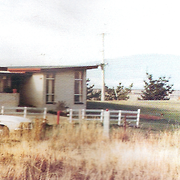
St Michael's Priory, Rokeby, 1974 - 1977, courtesy of The Hobart Clinic: the history.
Details
St Michael's Priory, in Rokeby, became an approved children's home in 1974. It accommodated children temporarily as part of a wider counselling and welfare service to the community of Rokeby. The Priory closed in 1977.
The monastic community that became St Michael's Priory began in a large house in Seymour Street, New Town, in about 1969. It was run by three Anglican Brothers, John (Jim) Turley, John (Jim) Smith, and Bob Cotton, who had taken religious vows of poverty, celibacy, and obedience. In about 1969, in order to accommodate increasing numbers of guests in need of help, the Brothers pooled their savings to buy nearly seven acres in Rokeby. They built a new house there. It had six or seven bedrooms, a dining room, lounge, and office with a separate chapel and vestry. According to Phillip Wright it was a 'classic 1970s style, besser brick with galvanised iron roof featuring "accent" brown trimmings and aluminium window frames throughout'. Later, the Brothers built another house using a loan from the Commonwealth government under the Homeless Person Act. The land supported a small farm of chickens, ducks, sheep, goats, and cows. There was also a market garden and hot house.
The Superintendent was Jim Turley, known as Brother John. He was an Anglican priest with qualifications as a psychologist, and a member of the Child Welfare Advisory Council. Jim Smith was also a priest and the Chaplain at the Royal Hobart Hospital for many years.
Smith's salary funded the Priory. It also received donations, contributions from guests, and, after 1974, some assistance from members of the Anglican Church. However, since it did not fit easily into a category, it only attracted small amounts of government funding. The Brothers were not paid.
St Michael's Priory took in adults and children described by the Mercury as having 'religious and emotional problems'. Some were homeless. Until 1974, most children were accompanied by their parents. Their length of stay was between one night and four months. The Brothers provided accommodation and food as well as counselling and help with daily living skills. People staying at the Priory paid board of $16 a day if they could and helped with the house work and cooking. Most did not want to work on the farm. The Brothers visited people in their homes and some came to the Priory for counselling. Turley described the Priory's activities as: 'Christ-centred and a work of mercy and love, not a formal, structured and fully subsidised response of the State'.
In February 1974, Turley applied to the Social Welfare Department for St Michael's Priory to become an approved children's home. He wrote:
As mentioned to you earlier, we have decided that the facilities of the home and the resources of its members may best be used in the short-term care of boys in necessitous circumstances who are under the direction of your Department, provided that the minimum age of the children concerned is 10 years and that where there is the possibility of keeping a family of brothers and sisters united, the home may accommodate the care of girls as well.
We would regard ourselves as a centre of assessment as well as care, and would look forward to cooperating with the officers of your Department with regard to the welfare of the children concerned and the best placement of the children...after they are allowed the opportunity of stability and security which we believe we could offer. At the same time we readily recognise that we could not provide long-term or permanent care for children as we do not feel we have the facilities or atmosphere necessary for such care.
Turley hoped to take six to eight children from the Department at any one time. They would live in a different house to the rest of the community. It was separated by a courtyard and had four bedrooms. A 'Mother' was appointed to take care of the children.
In 1974, the Bishop of Tasmania, Dr Robert Davies, spoke about the Priory in his presidential address to the Synod. Until then, the general public knew little about it. According to the Mercury, the reason was 'the conservative attitude of the church to what has been a radical project'. However, describing it as a 'a vital experiment in Christian service and witness', Davies now called on the Anglican Church to find $4000 a year to support the Priory.
The Priory had difficulties attracting novices and never reached the hoped for goal of five. At the same time, the cost of providing services became higher. In February 1977, the Anglican Church News announced that the Brothers would give up their community work, sell the Priory, and move to Ferntree, a Hobart suburb near Mount Wellington, to provide spiritual counselling and retreats.
According to Wright, a group of doctors purchased the Priory in 1977 to establish a private hospital for patients with mental health problems to receive treatment in a 'therapeutic community'. It later became the Hobart Clinic. In 2013, the Hobart Clinic Association, formed in 1984, occupies the site.
Sources used to compile this entry: 'The Bishop's presidential address', Church News, October 1974, pp. 5-6; 'John, Joseph and a commune', The Mercury, 10 September 1974, p. 1; 'Halfway house likely to close', The Mercury, 7 November 1975, p. 3; 'Rokeby Community to move', Church News, February 1977, p. 5; Campbell, TW, Religious communities of the Anglican Communion: Australia, New Zealand and the South Pacific, Author, Braddon, ACT, 2007, 231 pp, http://anglicanhistory.org/religious/campbell2007.pdf; Harris, Geoff, 'Chaplain ends stay: Rokeby post for Father Joseph', The Mercury, 7 February 1976, p. 9; Turley, JA, 'Priory's viewpoint is explained', Church News, December 1975, p. 4; Wright, Phillip JA, The Hobart Clinic: the history, The Hobart Clinic, Hobart, 2004, 24 pp.
Prepared by: Caroline Evans
Created: 14 May 2013, Last modified: 28 November 2014